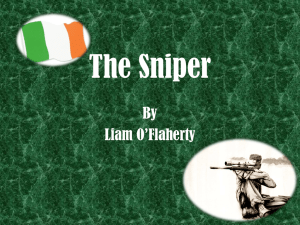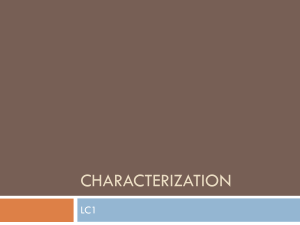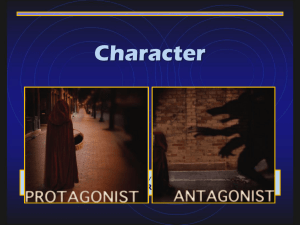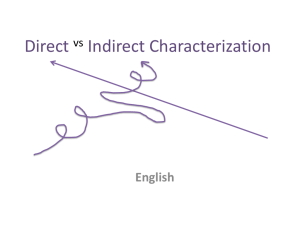TKAM LP2 - tokillamockingbirdunitplan
advertisement
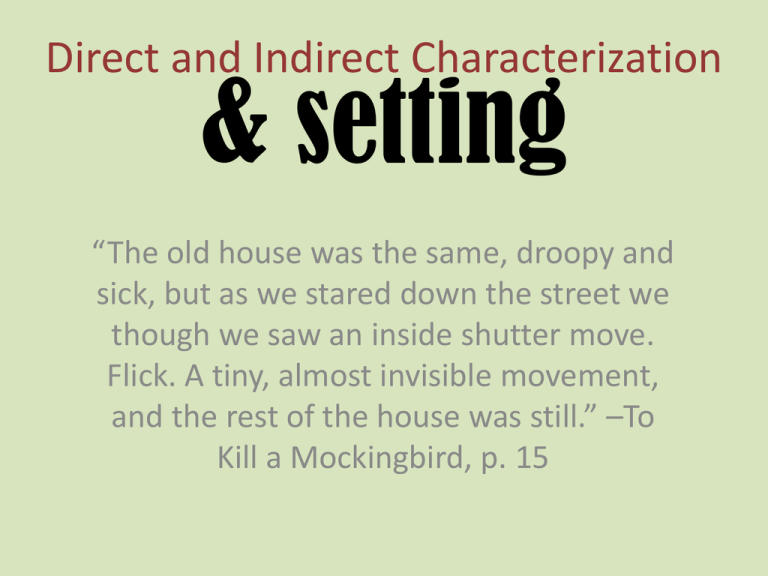
Direct and Indirect Characterization & setting “The old house was the same, droopy and sick, but as we stared down the street we though we saw an inside shutter move. Flick. A tiny, almost invisible movement, and the rest of the house was still.” –To Kill a Mockingbird, p. 15 Characterize Your ‘Hood • 1. Students will identify indirect and direct characterization of characters and setting in chapter one of TKAM. (E1-4.1, CCSS.ELALiteracy.RL-10.5) • 2. Students will apply indirect and direct characterization to descriptions of their own neighborhood. ( E1-5.3 CCSS.ELA-Literacy.W.910.3d) Today we WILL: Draw maps! Begin reading! Learn about Direct and Indirect Characterization! Why are we doing this? • To Kill A Mockingbird centers around a narrator who is growing up in a small town. The father of the story is involved in the central conflict and most of their community, Maycomb County, is against him. • By looking at our own childhood communities, we will begin to understand how the narrator, Scout, is perceiving the world and describing it back to us through direct and indirect characterization. Blank Sheet of Paper 1. Think back to the neighborhood/ apartment building/street you lived in or on when you were in elementary school. 2. Draw a map of this location. 3. Focus on what you DO remember, don’t worry too much about what you do NOT remember. *Where did you play? Was there a section you never went near? Why? Did any friends live near you? Use names casually. *We will be sharing for Participation Points! Calendar Characterization Two types of characterization: Direct and Indirect. Before we dive into either, let’s read the first paragraph of Chapter One. “When he was nearly thirteen, my brother Jem got his arm badly broken at the elbow. When it healed, and Jem’s fears of never being able to play football were assuaged (relieved), he was seldom (rarely) self conscious about his injury. His left arm was somewhat shorter than his right; when he stood or walked, the back of his hand was at right angles to his body, his thumb parallel to his thigh. He couldn’t have cared less, so long as he could pass and punt.” Direct Characterization Tells the audience what the personality of a character is. Example: The patient boy and quiet girl were both well-mannered and never disobeyed their mother. What is the boy like? What is the girl like? Indirect Characterization: Reading between the lines. Shows things that reveal the personality of a character. When it comes to Indirect Characterization, you have to “STEAL” the personality away from the text. What does the character say? How does the character speak? S Speech T Thoughts What is revealed through the character’s private thoughts and feelings? E What is revealed through the character’s effect on other people? How do other characters feel or behave in reaction to the character? A Effect on others Actions L Looks What does the character do? How does the character behave? What does the character look like? How does the character dress? Direct or Indirect? “When he was nearly thirteen, my brother Jem got his arm badly broken at the elbow. When it healed, and Jem’s fears of never being able to play football were assuaged (relieved), he was seldom (rarely) self conscious about his injury. His left arm was somewhat shorter than his right; when he stood or walked, the back of his hand was at right angles to his body, his thumb parallel to his thigh. He couldn’t have cared less, so long as he could pass and punt.” Characterization • As we read chapter one, you will find evidence of direct and indirect characterization of the community of Maycomb county and TWO other characters (besides Jem). Characterize your ‘hood! • Look back at the map you drew of your neighborhood. • Choose ONE aspect (your favorite hideout, the street you were supposed to avoid) and characterize that using TWO examples of direct characterization and THREE examples of indirect characterization. • 1-2 paragraphs, work until end of class • These are exit slips/one participation point for day. • Further your practice: This could be through direct/indirect characterization of a different aspect of your neighborhood OR if you would like to take a more artistic route, you may illustrate the aspect you originally wrote about however you like. Due by next class. • One extra participation point!


